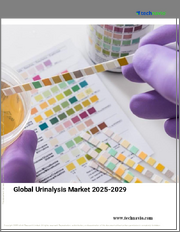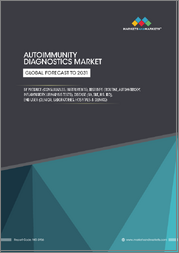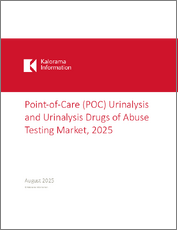
|
시장보고서
상품코드
1689829
세계의 소변 검사 시장 : 점유율 분석, 산업 동향, 통계, 성장 예측(2025-2030년)Global Urinalysis - Market Share Analysis, Industry Trends & Statistics, Growth Forecasts (2025 - 2030) |
||||||
세계의 소변 검사 시장은 예측 기간 동안 CAGR 7.5%를 기록할 전망입니다.

COVID-19의 발생은 소변 검사 시장에 영향을 주었고, 병원과 의료 서비스는 사회적 거리를 두는 조치로 서비스를 제한했습니다. 2021년 7월 International Journal of Surgery에 게재된 조사지에 의하면 COVID-19 팬데믹 동안 지연 또는 연기된 비뇨기과 치료에는 요로 감염, 스트레스성 실금, 과활동 방광(OAB), 신경인성 방광 등이 포함됩니다. 2021년 12월에 ADIAN 저널에 발표된 연구에 따르면, 1차 케어 서비스를 채용한 환자는 적고, 요로 결석을 포함한 진단도 적었습니다. 그리고 2020년 3월 30일부터 4월 24일 사이에 인구 10만명당 요로 결석 진단의 주간율은 잉글랜드에서 평균 30-35에서 10 이하로 감소했습니다. 이와 같이 유행기간 동안 시장은 악영향을 목격했습니다. 그러나 규제가 완화되고 COVID-19의 사례가 감소함에 따라 시장은 기세를 늘리기 시작하고 예측기간 동안에도 상승세가 계속될 것으로 예상됩니다.
당뇨병과 만성 신장병과 같은 만성 질환의 부담 증가와 포인트 오브 케어 검사의 적응 확대가 시장 성장의 주요 원인이 될 것으로 예상됩니다. 국제당뇨병연합(IDF)에 의한 2021년 12월 갱신에 따르면 2021년에는 약 5억 3,700만명의 성인(20-79세)이 당뇨병을 앓고 있으며, 2030년에는 6억 4,300만명, 20 45년에는 7억 8,300만명으로 증가할 것으로 예측되고 있습니다. 같은 정보원에 의하면, 성인의 당뇨병 환자의 4명에 3명이 저소득 및 중소득국에 살고 있으며, 그 중 거의 2명 중 1명(2억 4,000만명)이 진단을 받지 않았습니다. 또한 2021년에는 당뇨병으로 인해 670만명이 사망?습니다.
게다가, 세계에서 만성 신장병의 증례가 증가하고 있는 것도, 예측 기간 중 시장 성장을 가속할 것으로 예상되고 있습니다. 신장병은 공중위생상의 큰 문제가 되고 있습니다. 2021년에는 신장병은 세계에서 약 8억 5,000만 명에 영향을 미쳤습니다.
시장은 성장하는 태세에 있지만, 소변 검사와 관련된 엄격한 규제 체제가 예측 기간 동안 시장 성장을 방해할 수 있습니다.
소변 검사 시장 동향
예측기간 동안 임신 및 불임 치료 부문이 현저한 성장을 이룰 전망
소변 검사는 당뇨병, 탈수, 신장 또는 방광의 감염, 자간전증의 진단에 사용할 수 있습니다. 인간 융모성 성선자극호르몬(hCG)는 임신 중인 여성의 체내에서만 발생하는 독특한 호르몬으로 임신 검사 약물이 필요합니다.
임신과 불임의 검출을위한 소변 검사의 사용이 증가하고 있기 때문에 이 부문의 성장이 촉진 될 것으로 예상됩니다. 국립위생연구소가 2021년 9월 발표한 대표적인 기사에 따르면, 일반적으로 환자가 소변 임신 검사(UPT)에서 거짓 음성을 일으키는 원인은 2가지로 생각됩니다. 임신 초기의 경우에는 양성에 필요한 충분한 hCG가 분비되지 않을 가능성이 있습니다. 역치는 15-100mIU/mL로 알려져 있으며 가장 가능성이 높은 시나리오를 나타냅니다. 둘째, 더 걱정스러운 상황은 임신이 더 진행되고 "훅 효과"(hCG 상승 또는 과량이 소변 임신 검사 약물을 압도하고 위음성을 일으키는 것)으로 고통받는 환자 소변검사에서 음성이 되는 경우는 소변검사는 임신진단의 제일선택으로 여겨지고 있습니다. 2022년 4월, Mankind Pharma는 임신을 확인하기 위해 소변 검사에 사용되는 신속 검사 임신 장치를 출시했습니다.
예측기간 중 북미가 큰 점유율을 차지할 전망
북미는 고령화 인구 증가와 만성 신장병의 유병률이 높기 때문에 세계의 소변 검사 시장에서 큰 점유율을 차지할 것으로 예상됩니다. 만성 신장병은 신부전과 관련되어 있습니다. 또한, 이 자료에 따르면, 약 3,700만명이 이환하고 있습니다.
주요 제품의 상시, 시장 진출기업과 제조업체의 집중, 주요 기업간의 인수와 제휴, 미국에 있어서의 요로 결석이나 만성 신장병 증가 등은 동국에 있어서의 소변 검사 시장의 성장을 가속하는 요인의 일부입니다. 예를 들어, NCBI가 2021년 11월에 발표한 종이제에 따르면, 합병증이 없는 요로 감염의 유병률은 높고, 미국에서는 추정 40%의 여성이 평생 동안 요로 감염(UTI)을 발병할 가능성이 있습니다. 게다가 World Population Ageing Report 2020에 따르면 미국에서는 2030년까지 65세 이상의 인구가 8,481만 3,000명에 이를 것으로 예측되고 있으며, 총 인구에서 차지하는 65세 이상의 연령층의 비율은 2021년의 16.2%에서 2050년에는 22.4%로 상승할 수 있습니다. 비뇨기과 질환의 유병률은 나이가 들수록 증가하기 때문에 노인 증가도 이 나라 시장 성장을 가속할 것으로 예상됩니다.
소변 검사 산업 개요
소변검사시장은 세계 및 지역적으로 사업을 전개하는 기업이 소수 존재하기 때문에 경쟁은 완만합니다. 각 회사는 소변 검사 시장에서의 존재감을 높이기 위해 전략적 노력을 하고 있습니다. 현재 주요 진출기업으로는 Cardinal Health Inc., Alere(Abbott Laboratories), Beckman Coulter Inc., Siemens Healthineers, Roche Diagnostics, Sysmex Corporation, Bio-Rad Laboratories Inc., Arkray Inc., Acon Laboratories Inc., Becton, Dickinson, and Company 등이 있습니다.
기타 혜택
- 엑셀 형식 시장 예측(ME) 시트
- 3개월간의 애널리스트 서포트
목차
제1장 서론
- 조사의 전제조건과 시장 정의
- 조사 범위
제2장 조사 방법
제3장 주요 요약
제4장 시장 역학
- 시장 개요
- 시장 성장 촉진요인
- 만성 신장병의 부담증
- 포인트 오브 케어 검사에의 기호의 고조
- 시장 성장 억제요인
- 엄격한 규제 프레임워크
- Porter's Five Forces 분석
- 신규 참가업체의 위협
- 구매자/소비자의 협상력
- 공급기업의 협상력
- 대체품의 위협
- 경쟁 기업간 경쟁 관계의 강도
제5장 시장 세분화
- 제품 유형별
- 분석기기
- 자동분석장치
- 반자동 분석 장치
- 포인트 오브 케어 분석 장치
- 소모품
- 시약 및 키트
- 딥 스틱
- 소모품
- 분석기기
- 검사 유형별
- 생화학 검사
- 임신 및 출산 가능성
- 침지
- 용도별
- 질병 스크리닝
- 임신 및 출산 가능성
- 지역별
- 북미
- 미국
- 캐나다
- 멕시코
- 유럽
- 독일
- 영국
- 프랑스
- 이탈리아
- 스페인
- 기타 유럽
- 아시아태평양
- 중국
- 일본
- 인도
- 호주
- 한국
- 기타 아시아태평양
- 중동 및 아프리카
- GCC 국가
- 남아프리카
- 기타 중동 및 아프리카
- 남미
- 브라질
- 아르헨티나
- 기타 남미
- 북미
제6장 경쟁 구도
- 기업 프로파일
- Abbott Laboratories(Alere)
- Acon Laboratories Inc.
- Arkray Inc.
- Beckman Coulter Inc.
- Becton, Dickinson and Company
- Bio-Rad Laboratories Inc.
- Cardinal Health Inc.
- Roche Diagnostics
- Siemens Healthineers
- Sysmex Corporation
제7장 시장 기회와 앞으로의 동향
JHS 25.05.07The Global Urinalysis Market is expected to register a CAGR of 7.5% during the forecast period.
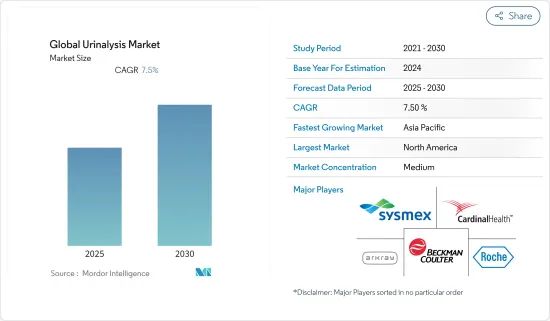
The outbreak of COVID-19 impacted the urinalysis market, as hospitals and healthcare services restricted services due to social distancing measures. The unprecedented increase in coronavirus-infected patients reduced access to other primary care services and resulted in a significant drop in non-COVID-19-related diagnoses, such as urinary tract infections or kidney diseases. For instance, according to a research article published in the International Journal of Surgery in July 2021, during the COVID-19 pandemic, urological procedures delayed or postponed included urinary tract infections, stress incontinence, overactive bladder (OAB), and neurogenic bladder. Similarly, according to a December 2021 study published in the ADIAN Journal, fewer patients adopted primary care services, and fewer diagnoses were done, including UTIs. The source also reports that between March 30 and April 24, 2020, the weekly rate of UTI diagnosis per 100,000 population fell from an average of 30-35 to less than 10 in England. Since April, the rate has risen by 50% of the usual rate. Thus, the market witnessed an adverse impact during the pandemic. However, with the ease of restrictions and declining cases of COVID-19, the market started to gain momentum and is expected to continue the upward trend over the forecast period.
The higher burden of chronic diseases such as diabetes and chronic kidney diseases and the rising adaptation of point-of-care testing is expected to be the major contributing factors to the market growth. Urinary tract infection refers to an infection in any part of the urinary system. For instance, as per a December 2021 update by the International Diabetes Federation (IDF), in 2021, approximately 537.0 million adults (20-79 years) had diabetes, which is projected to rise to 643.0 million by 2030 and 783.0 million by 2045. As per the same source, 3 in 4 adults with diabetes live in low- and middle-income countries and almost 1 in 2 (240 million) of them are undiagnosed. The source also reports that diabetes caused 6.7 million deaths in 2021. To identify the glucose level in diabetic people, urine analysis has proven to be an important test.
Furthermore, increasing cases of chronic kidney diseases across the globe are also expected to propel market growth over the forecast period. For instance, chronic kidney disease (CKD) is a condition that causes reduced kidney function over some time. It may develop over many years and lead to end-stage kidney (or renal) disease (ESRD). It has become an enormous public health issue. For instance, as per the 2021 report by the CDC, more than 15.0% of adults in the United States, amounting to approximately 37.0 million people, were estimated to have CKD. Similarly, in 2021, as per data released on World Kidney Day, a joint initiative of the International Society of Nephrology (ISN) and the International Federation of Kidney Foundations (IFKF), kidney disease affected around 850.0 million people globally. The same source also reported that one in ten adults has chronic kidney disease (CKD). The global burden of CKD is continuously increasing and is projected to become the 5th most common cause of years of life lost globally by 2040.
While the market is poised for growth, stringent regulatory frameworks related to urinalysis may hinder market growth over the forecast period.
Urinalysis Market Trends
The Pregnancy & Fertility Segment is Expected to Witness Considerable Segment Growth Over the Forecast Period
A urine test can be used to diagnose diabetes, dehydration, kidney or bladder infections, and preeclampsia. High sugar levels may be a sign of gestational diabetes, which may appear around week 20 of pregnancy. Human chorionic gonadotropin (hCG), a unique hormone that only arises in a woman's body during pregnancy, is what pregnancy tests seek. These tests can check for hCG in the blood or urine. Home urine tests for pregnancy are affordable and often used. Home pregnancy tests are fairly accurate when done correctly.
The increasing use of urinalysis for pregnancy and fertility detection is anticipated to propel segment growth. Several studies have been conducted to understand the accuracy of urinalysis in judging pregnancy. For instance, an article published in September 2021 by the National Institute of Health stated that, in general, there are two possible causes for a patient to have an erroneously negative Urine Pregnancy Test (UPT). Early pregnancy cases are where a patient may not produce enough human chorionic gonadotropin (hCG) to result in a positive test. A threshold that allegedly ranges from 15 to 100 mIU/mL represents the first and most likely scenario. Secondly, the circumstance that may be more worrisome is patients who are farther along in their pregnancy and suffer the "hook effect," which is when elevated or excessive amounts of hCG overwhelm the urinary pregnancy test and cause a false negative. Despite the certain cases where urine tests provide negative results, it is considered as the first line of diagnosis for pregnancy. Furthermore, continuous new launches of pregnancy tests by key players are also expected to augment the segment growth. For instance, in April 2022, Mankind Pharma launched a rapid-testing pregnancy device that is used for urinalysis to confirm pregnancy.
North America is Expected to Hold a Significant Share Over the Forecast Period
North America is expected to hold a major market share in the global urinalysis market due to the increasing aging population and higher prevalence of chronic kidney diseases. Chronic kidney disease is associated with kidney failure. According to 2021 data published by the National Kidney Foundation, chronic kidney disease causes more death than breast cancer and prostate cancer. The same source also stated that around 37.0 million people are affected by it. It is more prevalent in an older population, affecting approximately 15.0% of the adult population. Hence, the need for proper diagnosis and treatment of chronic kidney diseases in the region is expected to propel the demand for urinalysis.
Key product launches, high concentration of market players or manufacturers' presence, acquisitions and partnerships among major players, and rising cases of UTIs and chronic kidney diseases in the United States are some of the factors driving the growth of the urinalysis market in the country. For instance, as per an article published by the NCBI in November 2021, the prevalence of uncomplicated urinary tract infections is high, and an estimated 40% of women in the United States are likely to develop a Urinary Tract Infection (UTI) during their lifetime. Furthermore, the World Population Ageing Report 2020 stated that, in the United States, the number of people aged above 65 is projected to reach 84,813 thousand by 2030 and the 65-and-older age group's share in the total population may rise from 16.2% in 2021 to 22.4% by 2050. The prevalence of urological disorders increases with age, owing to which the increasing geriatric population is also expected to propel the market growth in the country.
Urinalysis Industry Overview
The urinalysis market is moderately competitive due to the presence of a few players operating globally as well as regionally. Companies are taking strategic initiatives to grow their presence in the urinalysis market. Currently, some of the major players include Cardinal Health Inc., Alere (Abbott Laboratories), Beckman Coulter Inc., Siemens Healthineers, Roche Diagnostics, Sysmex Corporation, Bio-Rad Laboratories Inc., Arkray Inc., Acon Laboratories Inc., Becton, Dickinson, and Company among others.
Additional Benefits:
- The market estimate (ME) sheet in Excel format
- 3 months of analyst support
TABLE OF CONTENTS
1 INTRODUCTION
- 1.1 Study Assumptions and Market Definition
- 1.2 Scope of the Study
2 RESEARCH METHODOLOGY
3 EXECUTIVE SUMMARY
4 MARKET DYNAMICS
- 4.1 Market Overview
- 4.2 Market Drivers
- 4.2.1 Growing Burden of Chronic Kidney Disease
- 4.2.2 Rising Preference for Point of Care Testing
- 4.3 Market Restraints
- 4.3.1 Stringent Regulatory framework
- 4.4 Porter's Five Forces Analysis
- 4.4.1 Threat of New Entrants
- 4.4.2 Bargaining Power of Buyers/Consumers
- 4.4.3 Bargaining Power of Suppliers
- 4.4.4 Threat of Substitute Products
- 4.4.5 Intensity of Competitive Rivalry
5 MARKET SEGMENTATION (Market Size - Value in USD Million)
- 5.1 By Product Type
- 5.1.1 Instruments
- 5.1.1.1 Automated Analyser
- 5.1.1.2 Semi-automated Analyzer
- 5.1.1.3 Point of Care Analyzer
- 5.1.2 Consumables
- 5.1.2.1 Reagents & Kits
- 5.1.2.2 Dipsticks
- 5.1.2.3 Disposables
- 5.1.1 Instruments
- 5.2 By Test Type
- 5.2.1 Biochemical
- 5.2.2 Pregnancy & Fertility
- 5.2.3 Sediment
- 5.3 By Application
- 5.3.1 Disease Screening
- 5.3.2 Pregnancy & Fertility
- 5.4 Geography
- 5.4.1 North America
- 5.4.1.1 United States
- 5.4.1.2 Canada
- 5.4.1.3 Mexico
- 5.4.2 Europe
- 5.4.2.1 Germany
- 5.4.2.2 United Kingdom
- 5.4.2.3 France
- 5.4.2.4 Italy
- 5.4.2.5 Spain
- 5.4.2.6 Rest of Europe
- 5.4.3 Asia-Pacific
- 5.4.3.1 China
- 5.4.3.2 Japan
- 5.4.3.3 India
- 5.4.3.4 Australia
- 5.4.3.5 South Korea
- 5.4.3.6 Rest of Asia-Pacific
- 5.4.4 Middle-East and Africa
- 5.4.4.1 GCC
- 5.4.4.2 South Africa
- 5.4.4.3 Rest of Middle-East and Africa
- 5.4.5 South America
- 5.4.5.1 Brazil
- 5.4.5.2 Argentina
- 5.4.5.3 Rest of South America
- 5.4.1 North America
6 COMPETITIVE LANDSCAPE
- 6.1 Company Profiles
- 6.1.1 Abbott Laboratories (Alere)
- 6.1.2 Acon Laboratories Inc.
- 6.1.3 Arkray Inc.
- 6.1.4 Beckman Coulter Inc.
- 6.1.5 Becton, Dickinson and Company
- 6.1.6 Bio-Rad Laboratories Inc.
- 6.1.7 Cardinal Health Inc.
- 6.1.8 Roche Diagnostics
- 6.1.9 Siemens Healthineers
- 6.1.10 Sysmex Corporation






